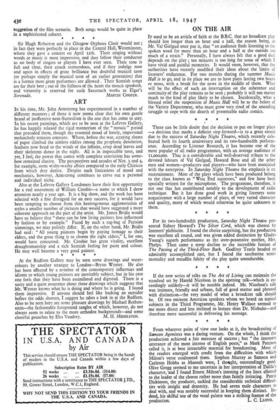ART
IN his time, Mr. John Armstrong has experimented in a number of different manners ; of these it now seems clear that his own gentle brand of inoffensive near-Surrealism is the one that has come to stay. In his recent paintings, which are to be seen at the Lefevre Gallery, he has happily relaxed the rigid mannerism of the "mosaic" period that preceded them, though the essential mood of lonely, impersonal melancholy remains constant. Where, before the war, straying sheets of paper climbed the aimless eddies emong the prophetic desolation, feathers now bend to the winds of the infinite, crisp dead leaves and their skeletons dance in the night. All is in impeccable taste, and yet, I feel, the power that comes with complete conviction has some- how remained elusive. The perspectives and arcades of Nos. 3 and 4, for example, seem wishy-washy affairs compared to the early Chiricos from which they derive. Despite such limitations of mood and mechanics, however, Armstrong continues to carve out a personal and individual niche.
Also at the Lefevre Gallery Londoners have their first opportunity for a real assessment of William Crosbie—a name to which I drew attention nearly a year ago. It is a big show, and the work has been selected with a fine disregard for an easy success, for it would have been tempting to choose from this heterogeneous agglomeration of styles a smaller number of pictures that would have suggested a more coherent approach on the part of the artist. Mr. James Bridie would have us believe that " there can be few living painters less influenced by fashion or by example." Faced by such a rag-hag of Parisian trimmings, we may politely differ. If, on the other hand, Mr. Bridie had said: " All young painters begin by paying homage to their elders, and the great thing is to choose the right elders," I, for one, would have concurred. Mr. Crosbie has great vitality, excellent draughtsmanship and a rich Scottish feeling for paint and colour. He may well become a very good painter. * * * * At the Redfern Gallery may be seen some drawings and water- colours by another stranger to London—Bryan Wynter. He also has been affected by a number of the contemporary influences and idioms to which young painters are inevitably subject, but in his case one feels that they have been assimilated and digested. There is a unity and a quiet assurance about these drawings which suggests that Mr. Wynter knows what he is doing and where he is going. I found them impressive. If anyone should feel like backing an outsider before the odds shorten, I suggest he takes a look in at the Redfern. Also to be seen here are some pleasant drawings by Michael Rothen- stein—the fashionable foreground tangles of which, however, do not always seem to relate to the more orthodox backgrounds—and some


































 Previous page
Previous page